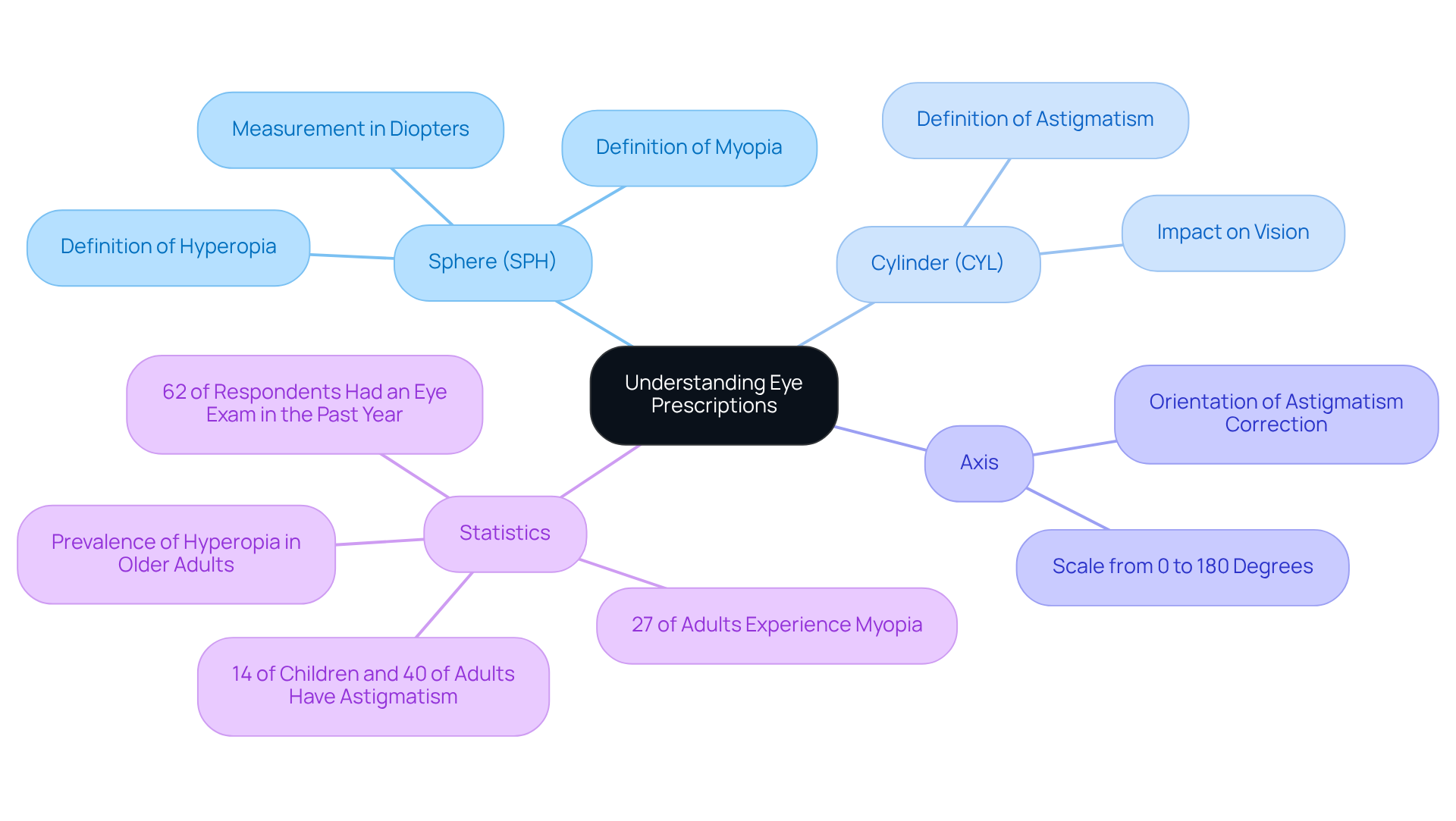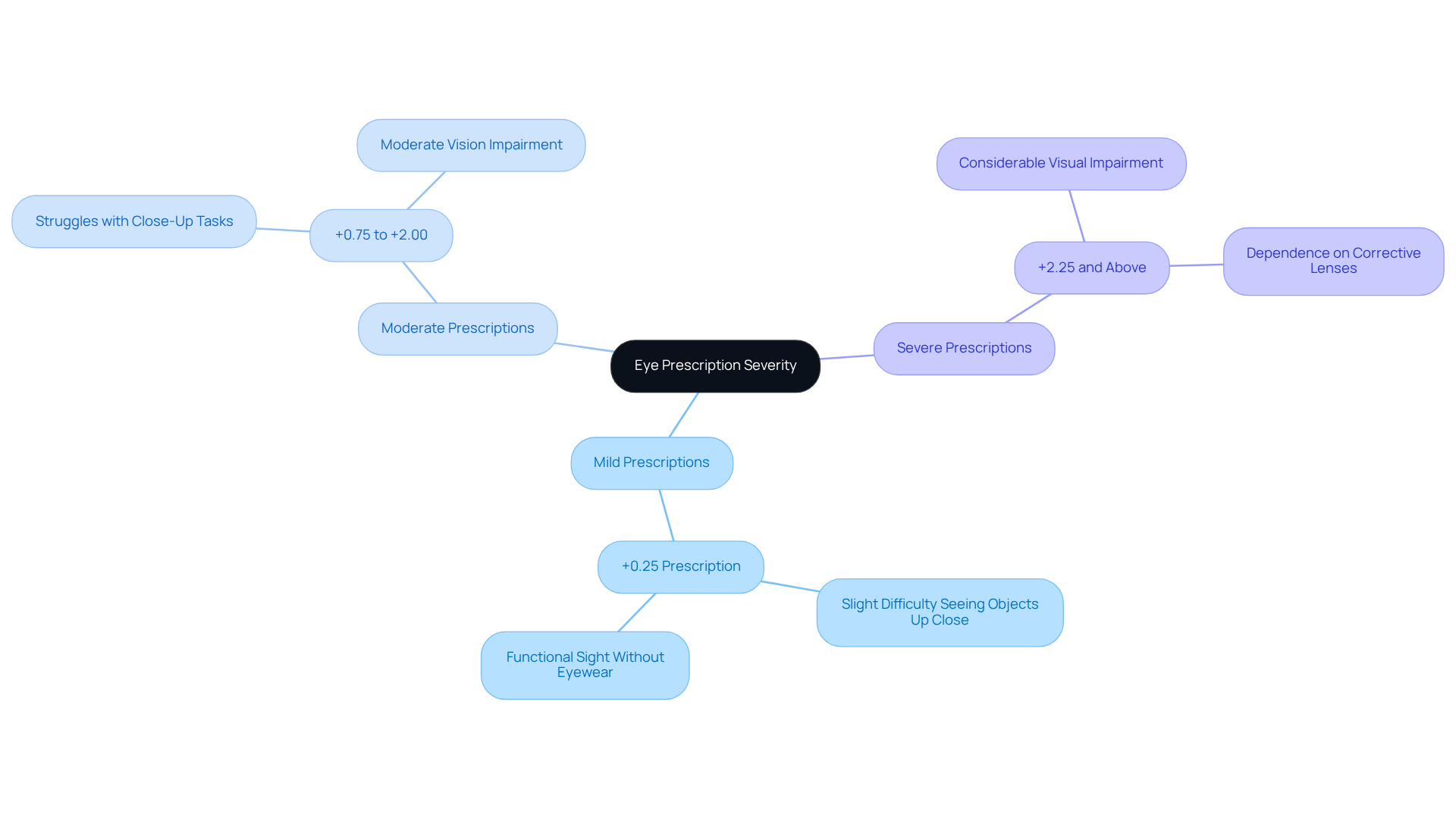Posted by: Northwest Eye in General on November 23, 2025
Introduction
Understanding eye prescriptions can feel overwhelming, especially when you encounter terms like +0.25, which indicates mild farsightedness. We understand that as refractive errors become more common, you might have questions about how your prescription affects your daily life. What does it really mean to have a +0.25 eye prescription? How does it stack up against more significant corrections?
This article aims to explore the impact of such a prescription. We’ll discuss its significance, the potential challenges it may present, and the importance of regular eye care in maintaining your vision. Remember, you’re not alone in this journey, and we are here to help you through the process.
Understanding Eye Prescriptions: Basics and Measurements
Eye prescriptions are made up of several important components: sphere (SPH), cylinder (CYL), and axis. We understand that navigating these terms can feel overwhelming, but knowing what they mean is crucial for your eye health. The sphere indicates the degree of nearsightedness or farsightedness, measured in diopters (D). A positive value, like +0.25, signifies mild farsightedness (hyperopia), while negative values indicate myopia. The cylinder measures astigmatism, which can affect your vision at all distances, and the axis shows the orientation of the astigmatism correction, specified on a scale from 0 to 180 degrees. Grasping these terms is essential, as they directly impact the quality and clarity of what you see.
Research shows that refractive errors, including myopia and hyperopia, are quite common, affecting many people. For instance:
- Around 27% of adults experience myopia.
- Hyperopia is also prevalent, especially among older individuals.
- Astigmatism affects roughly 14% of children and 40% of adults worldwide.
This highlights the importance of understanding the cylinder measurement when it comes to eyewear recommendations. Knowing your SPH, CYL, and axis is vital, as these measurements determine how effective your corrective lenses will be. Ophthalmologists stress that accurately interpreting these components is key to achieving optimal sight correction.
Regular eye exams are essential for early diagnosis and treatment of refractive errors. Studies indicate that 62% of respondents had an eye exam within the past year. It’s common to feel uncertain about how a -0.25 eye prescription can impact your daily life. For example, those with a -0.25 eye prescription might notice minor challenges with nearby tasks, while individuals with higher levels of hyperopia or myopia may face significant difficulties with both far and close tasks. Understanding how to interpret these components empowers you to engage more effectively with your eye care, ensuring you receive the right corrective measures tailored to your specific needs.
We are here to help you through this process, and we encourage you to prioritize your eye health. Remember, regular check-ups can make a world of difference!

Analyzing the +0.25 Eye Prescription: Implications for Vision
When considering a -0.25 eye prescription, how bad is that, as it indicates a very mild level of hyperopia? For most daily activities, this may not significantly impact your eyesight. Did you know that approximately 5% of children and 31% of adults worldwide experience hyperopia? This highlights how common this condition is.
Individuals with this lens often find minimal difficulty seeing objects up close, and many may not even need glasses. However, it’s common to feel slight visual strain during prolonged close-up activities, like reading or using digital devices.
As Sam Calderon notes, “Refractive errors, such as nearsightedness, farsightedness, and astigmatism, can lead to blurred vision at certain distances, and are often corrected with glasses or contact lenses.” The decision to wear glasses with this lens often depends on your comfort and specific visual needs.
Additionally, you might have heard of Computer Vision Syndrome (CVS), which describes visual issues that can arise from excessive screen time. This can affect those with minor corrective lens requirements during extended close-up tasks.
Addressing even mild visual discomfort is crucial. Unattended sight issues can have economic implications, so it’s important to consider corrective measures. Remember, we are here to help you through this process.

Comparing +0.25 with Other Common Eye Prescriptions: Severity and Impact
When considering a -0.25 eye prescription, how bad is that compared to other common corrections, as it is often seen as mild? We understand that many people may feel uncertain about their vision needs. For example, corrections between +0.75 and +2.00 indicate moderate hyperopia, where individuals might struggle significantly with close-up tasks. In contrast, severe measurements of +2.25 and above can lead to considerable visual impairment without corrective lenses.
Typically, many individuals wonder – 0.25 eye prescription how bad is that, as the effect of a +0.25 lens is slight and they can maintain functional sight without eyewear. However, as the number of medical orders increases, the need for corrective lenses becomes clearer. It’s common to feel concerned about these changes. Data shows that roughly 3 out of every 4 individuals in America require corrective lenses, highlighting how widespread sight correction needs are across various lens strengths.
Practical experiences reveal that patients often question – 0.25 eye prescription how bad is that when transitioning to stronger lenses, as they report greater difficulties with everyday tasks, such as reading or using digital devices. This underscores the importance of regular eye check-ups to monitor changes in vision. Remember, we are here to help you through this process and ensure your vision remains clear and comfortable.

Eye Health Context: The Role of Prescriptions in Managing Conditions
Eye assessments are vital for managing various eye conditions, including refractive errors like hyperopia and myopia. At Northwest Eye, we understand how important your vision is to you. Our extensive eye care services ensure that you receive the best possible management for your sight needs.
Routine eye examinations are essential for spotting changes in your vision. We understand that hearing you might need a -0.25 eye prescription how bad is that can be concerning, even if it seems mild. This can indicate the need for monitoring, especially as we age or if you experience symptoms like eye strain or headaches. By keeping your prescription accurate, you can maintain optimal visual health and comfort, reducing the risk of complications from untreated refractive errors.
Services Offered at Northwest Eye:
- Comprehensive eye exams
- LASIK surgery
- Pediatric eye care
- Treatment for cataracts
- Management of dry eye and glaucoma
Our specialists at Northwest Eye are dedicated to providing patient-centered solutions. We offer innovative options like the Light Adjustable Lens to enhance your eye health journey. We are here to help you through this process, ensuring you feel supported every step of the way.

Conclusion
Understanding the implications of a +0.25 eye prescription is essential for maintaining optimal vision health. We understand that while this mild level of hyperopia may not seem alarming, it serves as a gentle reminder of the importance of regular eye examinations and the need to monitor any changes in vision. Recognizing that even slight refractive errors can affect daily activities underscores the value of being proactive in eye care.
This article has explored the basics of eye prescriptions, detailing the components that define visual acuity, including sphere, cylinder, and axis measurements. It has highlighted the prevalence of refractive errors and emphasized that a +0.25 prescription typically results in minimal visual challenges for most individuals. However, it’s common to feel discomfort during close-up tasks, and those experiencing this should consider corrective measures. Untreated issues can lead to more significant problems down the line, and we want to ensure you feel comfortable and supported.
Ultimately, prioritizing eye health by scheduling regular check-ups and understanding one’s prescription is crucial. As refractive errors are common, being informed about their implications can empower you to make better decisions regarding your vision care. Taking action now can lead to clearer, more comfortable vision in the future, ensuring that even the mildest prescriptions are managed effectively. Remember, we are here to help you through this process.
Frequently Asked Questions
What are the main components of an eye prescription?
The main components of an eye prescription are sphere (SPH), cylinder (CYL), and axis.
What does the sphere measurement indicate?
The sphere measurement indicates the degree of nearsightedness (myopia) or farsightedness (hyperopia), measured in diopters (D). A positive value signifies mild farsightedness, while negative values indicate myopia.
How is astigmatism measured in an eye prescription?
Astigmatism is measured by the cylinder (CYL) component of the prescription, which affects vision at all distances.
What does the axis measurement represent?
The axis measurement represents the orientation of the astigmatism correction, specified on a scale from 0 to 180 degrees.
How common are refractive errors like myopia and hyperopia?
Around 27% of adults experience myopia, while hyperopia is prevalent, especially among older individuals.
What percentage of children and adults are affected by astigmatism?
Astigmatism affects roughly 14% of children and 40% of adults worldwide.
Why is it important to understand SPH, CYL, and axis measurements?
Understanding these measurements is vital as they determine how effective your corrective lenses will be and directly impact the quality and clarity of your vision.
How often should one have an eye exam?
Regular eye exams are essential for early diagnosis and treatment of refractive errors. Studies indicate that 62% of respondents had an eye exam within the past year.
How can a -0.25 eye prescription affect daily life?
Individuals with a -0.25 eye prescription might notice minor challenges with nearby tasks, while those with higher levels of hyperopia or myopia may face significant difficulties with both far and close tasks.
What should individuals do to prioritize their eye health?
Individuals should prioritize regular check-ups and engage effectively with their eye care to ensure they receive the right corrective measures tailored to their specific needs.






